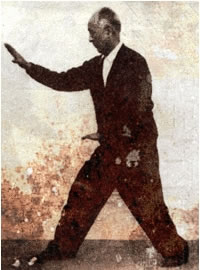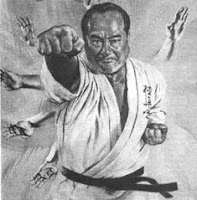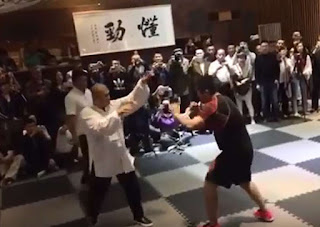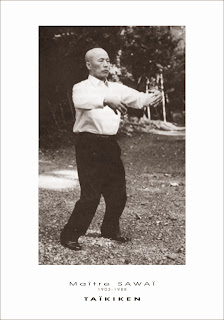Grounding
 “Grounding” (sometimes called “rooting”) is an essential skill in traditional martial arts and is often associated with the sanchin/sanzhan stance in many schools of karate and particularly external southern Chinese arts. It also features strongly in the internal arts of xingyi and its offshoot yi quan (see my articles “Sanchin in the Chinese martial arts”, “The naming of sanchin” and “Seisan - the universal kata” where I suggest a link between sanchin and xingyi’s “san ti” posture which utilises a stance sometimes called “zhan bu” (battle stance)).
“Grounding” (sometimes called “rooting”) is an essential skill in traditional martial arts and is often associated with the sanchin/sanzhan stance in many schools of karate and particularly external southern Chinese arts. It also features strongly in the internal arts of xingyi and its offshoot yi quan (see my articles “Sanchin in the Chinese martial arts”, “The naming of sanchin” and “Seisan - the universal kata” where I suggest a link between sanchin and xingyi’s “san ti” posture which utilises a stance sometimes called “zhan bu” (battle stance)).In our school we practise a kind of “standing pushing” exercise in sanchin intended to develop and test grounding. Both partners stand in sanchin at bent elbow range – one hand on the hip, one hand on the shoulder. There are no “rules” other than “no leaning” and “no sudden or pulsating thrusts”. The drill is illustrated in the video below:
Sanchin pushing
So far I've been able to resist such “standing pushing” by far stronger/heavier men in the gym (provided they don't lean in with a significantly larger body mass).
As a matter of interest, I filmed this after I'd lost 18 kg in hospital - yet I was still able to push over larger people without much loss of "grounding" ability. It goes to show how grounding relies on correct technique for momentum transfer, not power (see my article “Hitting harder: physics made easy”).
In this context it is also easy to see how “sanchin pushing” might be assumed to have a “paranormal” element (more on that in a moment). I can assure you it does not.
So how does it work? It relies on efficient posture and lowering your centre of gravity. It is not, of itself, a "combat technique", nor is it just a cheap "parlour trick". Rather it is evidence of good, basic grounding.
 I'm not going to start a lengthy physics dissection here (as I did more generally in my article “Hitting harder: physics made easy”). Suffice it to say that good grounding gives you a foundation for generating or receiving any applied force; weak grounding does not. Good grounding involves the correct (optimum) posture to create or receive a push/force etc. That's why leaning isn’t allowed – we are testing each other's stability, not who has the greater mass.
I'm not going to start a lengthy physics dissection here (as I did more generally in my article “Hitting harder: physics made easy”). Suffice it to say that good grounding gives you a foundation for generating or receiving any applied force; weak grounding does not. Good grounding involves the correct (optimum) posture to create or receive a push/force etc. That's why leaning isn’t allowed – we are testing each other's stability, not who has the greater mass.The pushing exercise shown above does not need to be done in sanchin. It can be done in any stance once you acquire sufficient skill. I've found that grounding translates to every other stance. I have the same results in shiko dachi (horse stance) and even natural stance. However grounding is easier to learn in sanchin. Why? Sanchin lets you use the “shime” or pelvic thrust (see my article “Whole lotta shakin’: addendum”) to add a forward and upward moment.
The "shime" is obvious with beginners and becomes more subtle as you gain experience until it is barely discernible. This is just one variable and works in sanchin particularly.
 Good grounding is a prerequisite for applying "softer"/"internal-type" techniques (ie. those that focus on the efficient transfer of momentum rather than on power – see my articles “Internal vs. external martial arts”, “Hitting harder: physics made easy” and “Understanding the internal arts”).
Good grounding is a prerequisite for applying "softer"/"internal-type" techniques (ie. those that focus on the efficient transfer of momentum rather than on power – see my articles “Internal vs. external martial arts”, “Hitting harder: physics made easy” and “Understanding the internal arts”).Sanchin pushing is one of the "internal" things I do which I could, if I choose, pass off as some kind of “chi”/“ki” because it has people scratching their heads. The biomechanics are not obvious. The fact that I have bent my knees to a particular point and no further, aligned my back and hips in a particular way, performed a subtle "shime" as noted above goes unnoticed to the untrained eye.
It is important to note that in the video Tim is not being "compliant" in letting me push him (except in so far as he isn't "cheating" in this exercise by leaning in). In fact, most of my students try to beat me in this exercise and I encourage it (I even get "challenges" after class - we all know it isn't "combat" but people are, by nature, competitive).
Sometimes the more senior students do beat me (not often!) (in my experience skill in sanchin pushing/grounding correlates with years of training). This is a big difference to many purported “internal” schools of the kind I refer to in my article “Understanding the internal arts” where students let themselves be “thrown” many metres by the mere wave of a hand. As discussed in that article, I do not, for one minute, think this is anything but fake. The students are complicit in their teacher's faking (whether consciously or subconsciously). As it happens, no one I know is in such debt, or holds me in such "awe", that they will fall down when I merely wave my hand!
In this regard, you'll note that Tim doesn't fly away with great speed, only to fall, flailing in agony, on the floor. In this case I was more stable (and able to withstand his "standing push"). Any more grandiose claim than that would be false in my experience and opinion.
 And in case there is any doubt, Tim was trying to push hard – except that I’d got the upper hand and he’d lost any base from which to push. The "no leaning rule" also means he couldn't go down to a rugby posture and “salvage” his situation.
And in case there is any doubt, Tim was trying to push hard – except that I’d got the upper hand and he’d lost any base from which to push. The "no leaning rule" also means he couldn't go down to a rugby posture and “salvage” his situation.In this case I wasn't pushing hard - I had lots to spare; my stance was doing the work. He was attempting to push from a weaker base, so I could use minimal arm force to keep him at bay. With most beginners (even those who are big and heavy) I often don't need to use my arms at all...
So how does it feel? If your opponent is better than you it should (and does) feel like you're pushing a brick wall. If you are better than your opponent, it feels like he's pushing himself backwards and you feel “like a brick wall”...
If you're very evenly matched with your partner then it is touch and go as to who gets the upper hand – but once someone does, it goes back to the "wall" feeling and you know then that “it's all over, red rover”.
Copyright © 2008 Dejan Djurdjevic



Shihan,I'm afraid that no matter how much you try to explain it away or break it down - you're sanchin, in my mind atleast, is paranormal.
ReplyDeleteWitch Doctor...
Excellent coverage of an elusive topic.
ReplyDeleteThere's nothing superhuman about sanchin, but it does take severe effort to make it effective. Your drill seems like a neat tool for augmenting the kata.
Best,
Matt
I normally use a sideways horse stance to demonstrate how much force it can resist coming from the front. Someone almost 100 pounds heavier than me, had him push my forearms through and I didn't move. Because all the force went into my shoulders, then my spine, and then my legs which were locked straight, in structure, and he was basically trying to push the floor through. Not going to work using muscles.
ReplyDeleteI'm going to comment this time, not that any idiot will understand it.
ReplyDeleteI just read another article that claimed to "debunk" the use of chi in martial arts, saying it only works in a demonstration when the master has previously instructed the student to act a certain way for it all to look 'believable' by an observer. I couldn't comment without logging in and receive their needless ignorance by email weekly.
But I'll say it right here.
There are WAY more unbelievable things in this reality than mere Grounding/Rooting using chi/energy. This is mere child's play. It would be lesson one in your martial arts education, "how to ground yourself BEFORE you can throw a punch or a fancy kick to astonish children with your prowess".
To ignore a science (that may either border or CONVERGE with the realm of "magick", intended as the use of and manipulation of energy through one's own willpower and chi/vril/prana/aura/whatever-you-call-your-energy) that has been around for at least 4 millennia, dating AT LEAST back to Ancient Egypt and Greece (most likely further back in time) is to ignore Knowledge that was passed on from generation to generation, lost, re-discovered by those who have taken it upon themselves to study it regardless of the nearly inexistent information of some ages (think Medieval age, where those with spiritual knowledge met only the flames given by the fearful and ignorant who hoped to eradicate it... and failed). To ignore this Knowledge (that can do a helluva lot more than just grounding you (simplest example: healing through energy from virtually anything) is to ignore the Gods' given infinite ability of the Human being. At the state we're in, it's no wonder many feel that they can "debunk" something that not many can already do. But to DENY that this thousands of years old Knowledge is a fraud is just as pointless as to deny fish swim in the Sea.
In conclusion, I'm glad to see more people are taking it upon themselves to share this Knowledge in the hope that it will, a day soon to come, COMMON Knowledge.
You can't teach Truth to the willingly blind and deaf.